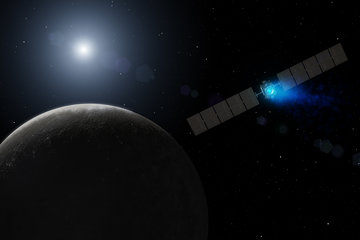A gas giant with an interesting atmosphere
At an exoplanet 300 light-years away, the first measurement of carbon-13 succeeds
More than 4600 planets in distant stars are known so far. Many of these celestial bodies have more or less dense gas shells similar to the Earth. Now, for the first time, researchers, including those from the Max Planck Institute for Astronomy in Heidelberg, have detected various forms of carbon in the atmosphere of an exoplanet designated TYC 8998-760-1 b. Its observation with ESO's Very Large Telescope in Chile revealed a relatively high proportion of carbon-13, suggesting that the gas giant, which is about 300 light-years away in the constellation Fly, formed at a large distance from its parent star.

Isotopes are different forms of the same atom but with a varying number of neutrons in the nucleus. For example, carbon with six protons typically has six neutrons (carbon-12), but occasionally seven (carbon-13) or eight (carbon-14). This property does not change much the chemical properties of carbon. Still, isotopes form in different ways and often react slightly differently to the prevailing conditions. Isotopes, therefore, provide applications in a wide range of research fields: from detecting cardiovascular disease or cancer to studying climate change and determining the age of fossils and rocks.
Astronomers from several countries, among them Paul Mollière from the Max Planck Institute for Astronomy (MPIA) in Heidelberg, Germany, discovered an unusual ratio between those isotopes in the atmosphere of the young giant planet TYC 8998-760-1 b. Carbon is present primarily in the form of CO (carbon monoxide) gas. The planet itself exhibits a mass of about 14 Jupiter masses and has almost twice the size of Jupiter. Therefore, astronomers classify it as a super-Jupiter.
The group of scientists, led by first author Yapeng Zhang, a PhD student at Leiden Observatory, The Netherlands, successfully distinguished carbon-13 from carbon-12 because it absorbs radiation at slightly different colours. “It is really quite special that we can measure this in an exoplanet atmosphere, at such a large distance,” says Zhang. The astronomers had expected to detect about one in 70 carbon atoms to be carbon-13, but it seems to be twice as much for this planet. The idea is that the higher abundance of carbon-13 is somehow related to the formation of the exoplanet.

Mollière explains: “The planet is more than one hundred and fifty times farther away from its parent star than our Earth is from our Sun. At such a great distance, ices have possibly formed with more carbon-13, causing the higher fraction of this isotope in the planet’s atmosphere today.” Suppose the enrichment in carbon-13 is connected to the freeze-out of CO in the planet-forming protoplanetary disks. In that case, this could mean that Solar System planets did not collect much carbon-13-rich ice. A reason may be that in the Solar System, the distance beyond which CO begins to freeze out of the gas phase, known as the CO snowline, lies beyond Neptune’s orbit. Therefore, CO ices have likely rarely been incorporated into the Solar System planets, leading to a higher isotope ratio. Mollière wrote the data analysis software and contributed to interpreting the results.
The exoplanet itself, TYC 8998-760-1 b, was discovered only two years ago by Leiden PhD student Alexander Bohn, co-author of the article. He adds: “It’s awesome that this discovery has been made close to ‘my’ planet. It will probably be the first of many.”
Ignas Snellen, professor in Leiden and the driving force behind this subject for many years, is above all proud. “The expectation is that in the future, isotopes will further help to understand exactly how, where and when planets form. This result is just the beginning.”
MN / HOR













